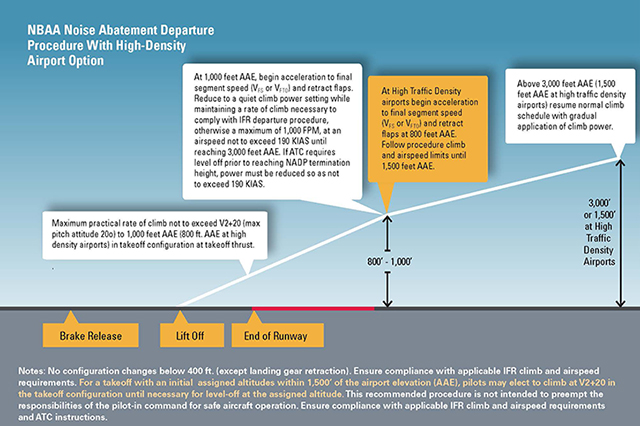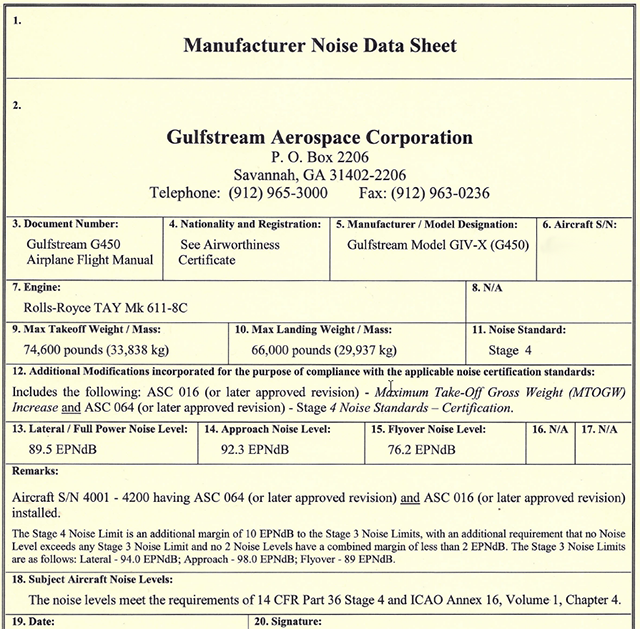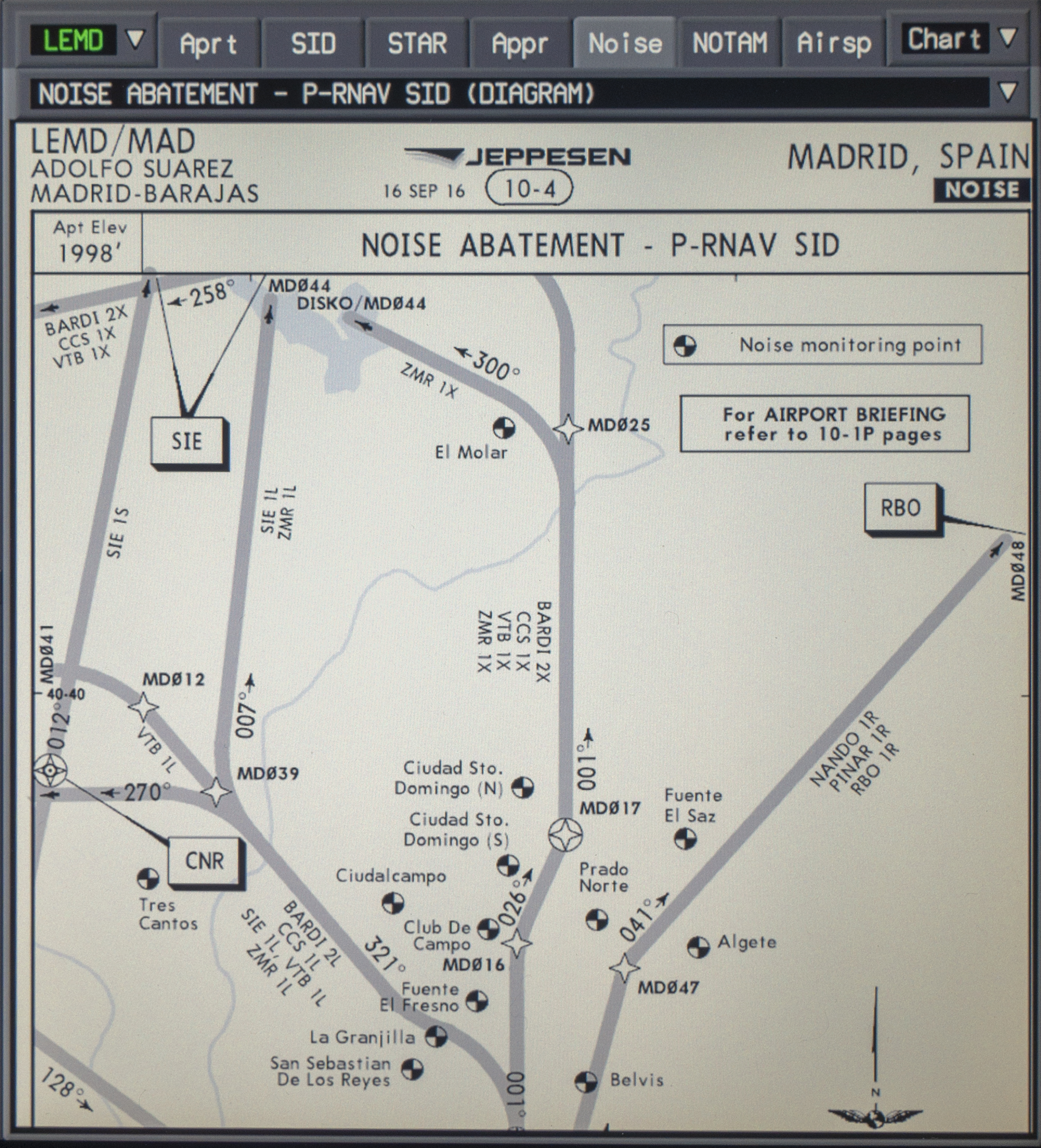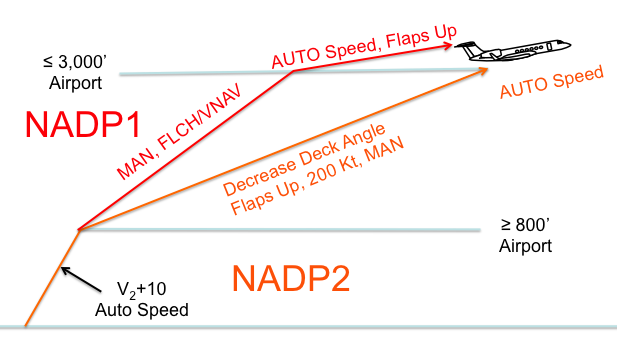Noise abatement has gotten easier but you still need to pay attention to local rules to stay out of trouble. Here's a quick primer.
— James Albright

Updated:
2020-10-29
Noise standards are somewhat aligned in the world, but there remains a bit of nomenclature difference. You should have a certificate that shows where in the standards you reside. No matter what level of noise your aircraft produces, there are procedures you might have to follow.
You can also find noise abatement procedures for several airports at: https://whispertrack.com.
2 — United States noise standards
4 — ICAO noise abatement procedures

1
ICAO noise standards
Chapters 2 through 4 list evolving ICAO noise standards over time. These chapters are where we get "stages" of noise compliance. An aircraft that complies with chapter 2, for example, is "Stage 2 compliant." The G450 complies with chapter 4, hence our Stage 4 designation. There really isn't a "Stage 1" compliance, we simply refer to really noisy airplanes as Stage 1.
- Subsonic jet aeroplanes, type certificate before 6 October 1977
- At lateral noise measurement point: 106 EPNdB for aeroplanes with maximum certificated take-off mass of 400,000 kg or over, decreasing linearly with the logarithm of the mass down to 97 EPNdB at 35,000 kg, after which the limits remain constant.
- At fly over noise measurement point (Aeroplanes with two engines or less): 104 EPNdB for aeroplanes with maximum certificated take-off mass of 325,000 kg or over, decreasing linearly with the logarithm of the mass at the rate of 4 EPNdB per halving on mass down to 93 EPNdB, after which the limits remain constant.
- At approach noise measurement point: 108 EPNdB for aeroplanes with maximum certificated take-off mass of 280,000 kg or over, decreasing linearly with the logarithm of the mass down to 101 EPNdB at 35,000 kg, after which the limits remain constant.
- Subsonic jet aeroplanes, type certificate after 6 October 1977 and before 1 January 2006
- At lateral noise measurement point: 103 EPNdB for aeroplanes with maximum certificated take-off mass of 400,000 kg or over, decreasing linearly with the logarithm of the mass down to 94 EPNdB at 35,000 kg, after which the limits remain constant.
- At fly over noise measurement point (Aeroplanes with two engines or less): 101 EPNdB for aeroplanes with maximum certificated take-off mass of 325,000 kg or over, decreasing linearly with the logarithm of the mass at the rate of 4 EPNdB per halving on mass down to 89 EPNdB, after which the limits remain constant.
- At approach noise measurement point: 105 EPNdB for aeroplanes with maximum certificated take-off mass of 280,000 kg or over, decreasing linearly with the logarithm of the mass down to 98 EPNdB at 35,000 kg, after which the limits remain constant.
- Maximum noise levels can be exceeded at one or two measurement points, but the sum of the excesses cannot be greater than 3 EPNdB, no single point can be greater than 2 EPNdB than the limit, and the excesses can be offset by corresponding reductions at other points.
- Subsonic jet aeroplanes, type certificate on or after 1 January 2006
- The standards are the same as Chapter 3 but the trade offs are stricter.
- The maximum permitted noise level cannot be exceeded at any of the measurement points.
- The sum of the three measurement points shall be at least 10 EPNdB less than the sum of the standard at each point.
- The sum of any two measurement points shall be at least 2 EPNdB less than the maximum noise levels at each point.
Source: ICAO Annex 16, Vol I
2
United States noise standards
The U.S. FAA "Stage" noise standards are similar to the ICAO "Chapter" noise standards:
- ICAO Annex 16, Chapter 2 — 14 CFR 36 "Stage 2"
- ICAO Annex 16, Chapter 3 — 14 CFR 36 "Stage 3"
- ICAO Annex 16, Chapter 4 — 14 CFR 36 "Stage 4"
Source: 14 CFR 36 Appendix B §Section B36.5, Maximum Noise Levels
4
ICAO noise abatement procedures
The noise abatement procedure specified by an operator for any one aeroplane type should be the same for all aerodromes.
Source: ICAO Doc 8168, Vol I §7, ¶3.2.3.b.
Life has gotten easier because of this new ICAO stipulation, we can no longer have noise abatement procedures tailored to individual airports. Gulfstream has decided the normal procedures used in day-to-day operations are the procedures you will use to meet noise abatement requirements. Unless you are operating under JAA/EASA, you don't need to know any other noise abatement procedure. Or do you? First we'll cover the Noise Information Manual procedures and then move on to JAA/EASA.
5
NBAA departure noise abatement procedures

NBAA Noise Abatement Departure Procedure, from NBAA Website
In 2015 the NBAA revised their recommended noise abatement procedures to more closely reflect ICAO norms . . .
- Climb at maximum practical rate not to exceed V2+20 KIAS (maximum pitch, attitude 20 degrees) to 1,000 feet AAE (800 ft. AAE at high density traffic airports) in takeoff configuration at takeoff thrust.
- Between 800 and 1,000 feet AAE, begin acceleration to final segment speed (VFS or VFTO) and retract flaps. Reduce to a quiet climb power setting while maintaining a rate of climb necessary to comply with IFR departure procedure, otherwise a maximum of 1,000 FPM at an airspeed not to exceed 190 KIAS, until reaching 3,000 feet AAE or 1,500 feet AAE at high density traffic airports. If ATC requires level off prior to reaching NADP termination height, power must be reduced so as not to exceed 190 KIAS.
- Above 3,000 feet AAE (1,500 feet at high density airports) resume normal climb schedule with gradual application of climb power.
- Ensure compliance with applicable IFR climb and airspeed requirements at all times.
Source: NBAA Website
6
Gulfstreams
Source:
Back in the old days, Gulfstream had a Noise Information Manual (NIM) that had specific procedures for many U.S. and world airports that were a bit of a handful to manage and memorize. They got called on this by several worldwide agencies and were told to have only one or two procedures. So they gave us U.S. operators the idea that you use normal procedures at specified flap and thrust settings and you will be okay. But they do offer their JAA/EASA operators a better way.
Gulfstream issued a JAA Operating Manual Supplement, GAC-OMS-02, Noise Abatement Departure Procedures for JAA/EASA Operators, that offers two other noise abatement departure procedures. To that end, the JAA supplement offers two noise abatement procedures.
Noise Abatement Departure Procedure 1 - Close In Noise Reduction
- After takeoff from the departure airport, the initial climb speed shall not be less than V2+10 kt. Automatic speed targets will produce the speed target of V2+10 kt as a factor of normal rotation rates at any takeoff weight.
- On reaching an altitude at or above 240 m (800 ft) above airport level, select MANual under the Guidance Panel Speed window then select climb power by selecting VNAV or FLCH on the Guidance Panel. The autothrottle will then adjust power to the climb rating. Maintain a climb speed of V2+10 to 20 kt with flaps in the take-off configuration. Should the Standard Instrument Departure Procedure require a turn any time during the departure, maintain a minimum speed of V2+10 kt while in the turn.
- At no more than an altitude equivalent to 900 m (3,000 ft) above airport level, while maintaining a positive rate of climb, deselect MANual under the Guidance Panel Speed window and accelerate and retract flaps on schedule. Limit bank angles to 15 degrees while the flaps are retracting until reaching a speed greater than VREF on the speed tape.
- At 900 m (3,000 ft) above airport level, accelerate to en-route climb speed in the clean configuration.
Source: GAC-OMS-02, pg. 4
This procedure is easier than the description makes it seem. Simply use normal takeoff procedures, leave the flaps set, select manual speeds before 800' and auto speeds at 3,000' for a normal clean up. So what happens when you do this?
- The performance computer will set V2 as your target speed prior to takeoff.
- On rotation, if you still have both engines, the performance computer sets V2+10 and keeps that.
- The performance computer normally raises the target speed to 200 if you raise the flaps and then 250 once leaving the airport traffic area. You stop the first by keeping the flaps set and the second by selecting MANUAL speeds at 800 feet.
- Once you reach 3,000' AGL and select AUTO speeds, the performance computer will select 220 knots, which is VFE for 20° flaps.
- Flap retract speed is VREF+20, which you will have almost immediately. When you retract the flaps the performance computer will select 250 knots.
- At this point the aircraft and performance computer are in normal configurations.
Note: the display controller will indicate VREF for 20° flaps when the flap handle is set to 20° reassuring you that you can retract the flaps safely. The second the flap handle goes to 0° the VREF increases for a clean configuration and you will appear to be below VREF. Of course you are not.
See the video: ELLX Takeoff Runway 06 for demo of these procedures at Luxembourg.
Noise Abatement Departure Procedure 2 (NADP 2) – Distant Noise Reduction
- After takeoff from the departure airport, the initial climb speed shall not be less than V2+10 kt. As noted earlier the automatic speed targets will produce the speed target of V2+10 kt as a factor of normal rotation rates at any weight.
- On reaching an altitude equivalent to at least 240 m (800 ft) above aerodrome level, decrease aircraft body angle/angle of pitch while maintaining a positive rate of climb, retract flaps and accelerate towards VZF (200 kt). Doing so will result in the automatic speed target changing to 200 kt. Select MANual speed then select either VNAV or FLCH on the Guidance Panel. The autothrottle will reduce power to the climb rating. Limit bank angle to 15 degrees while the flaps are retracting until reaching a speed greater than VREF on the speed tape.
- Maintain a positive rate of climb and accelerate to and maintain a climb speed of 200 kt until 900 m (3,000 ft) above aerodrome level.
- On reaching 900 m (3,000 ft) above aerodrome level, deselect MANual under the Speed window on the Guidance Panel and transition to normal en-route climb speed.
Source: GAC-OMS-02, pg. 5
References
(Source material)
14 CFR 36, Title 14: Noise Standards: Aircraft Type and Airworthiness Certification, Federal Aviation Administration, Department of Transportation
Gulfstream JAA Operating Manual Supplement for GIV, GIV-SP, G400, G300, G450, GV, G500, and G550 Airplanes, Supplement Number GAC-OMS-02: Noise Abatement Departure Procedures for JAA/EASA Operators, Basic Issue, June 25, 2008
Gulfstream Noise Information Manual, Revision 12, Sept 1, 2011
ICAO Annex 16 - Environmental Protection - Vol I - Aircraft Noise, International Standards and Recommended Practices, Annex 16 to the Convention on International Civil Aviation, Vol I, July 2008
ICAO Doc 8168 - Aircraft Operations - Vol I - Flight Procedures, Procedures for Air Navigation Services, International Civil Aviation Organization, 2006
NBAA Recommended Noise Abatement Departure Procedure
Please note: Gulfstream Aerospace Corporation has no affiliation or connection whatsoever with this website, and Gulfstream does not review, endorse, or approve any of the content included on the site. As a result, Gulfstream is not responsible or liable for your use of any materials or information obtained from this site.



